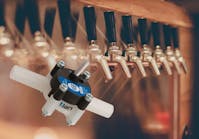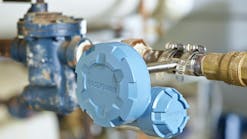Maximize machinery life with lubrication and IIoT
As the process manufacturing world takes advantage of innovations spilling out of the tech sector, the Industrial Internet of Things (IIoT) continues to grow rapidly. The days of timers and relays are quickly disappearing, as is the practice of reading the proverbial “tea leaves” to plan maintenance activities. Instead, new technologies empower integration of plant-wide control systems with condition monitoring that enables real-time passive and active maintenance.
Picture building an algorithm based on a parameter set to monitor and adjust lubrication in real time for a sensitive/critical piece of equipment. In the past, this would be impossible to accomplish — today, it is a reality. Now, imagine that same parameter set adjusted in real time by artificial intelligence (AI) based on historical data to extend the equipment’s life. As machine learning (ML) and AI start to permeate our industry, these “passive” or automated means of real-time maintenance are becoming the norm.
Consider that same AI assisting with activities to maximize lubricant life. These actions may include scheduling filter changes, evaluating a fluid’s remaining life or determining when to change filter ratings or oil type. Using IIoT technology, for example, a particle counter at an AI-enabled “smart facility” could actively manage maintenance activities. This system would hold historical data for a piece of equipment’s operating conditions and use that, along with live feedback, to make recommendations.
Also consider that this facility scans in all products at the shipping department and scans them out of stores when removed by maintenance personnel, all via QR codes. That same AI could detect if the wrong oil or filter is used (based on the QR information) or monitor the in-service lubricant to evaluate ISO cleanliness targets. This data could then determine if the filter element’s micron and beta rating needs to be improved. After identifying all of this, the system could automatically order new filters and schedule that filter’s installation — all without the input of anyone at that facility. It is easy to see the potential.
This may seem to be a bit pie in the sky. It is, however, the dream that industry is pushing toward and the vision that is driving many of the advances coming into the market today. Here are a few instruments/technologies to consider when evaluating ways to leverage IIoT for lubrication management.
Particle counters: A great tool to ensure the cleanliness of oil. Mostly seen for larger hydraulic systems, these sensors will often also provide temperature readings and typically display ratings in ISO, SAE or both formats. (Figure 1.)
Conductivity sensors: Most oils have low conductivity, and monitoring for increases can give a good indication of component wear. The abrasion of conductive materials in a piece of equipment will lead to an increase of conductivity for the oil. As the level of suspended conductive impurities rises, so does the indication of mechanical wear. Step changes over time can show — especially when supported by other monitoring means — that a piece of equipment needs to be scheduled for service.
Water saturation sensors: Adding water to lubricants reduces lubricity and has other detrimental effects, such as increased varnish. A water saturation sensor allows you to monitor levels and act as needed to correct for water egress into a system. Monitoring for step changes can also indicate things like failed oil coolers that rely on process water for cooling.
Temperature sensors: Reduction in lubrication has the obvious effect of increased friction. As such, monitoring for temperature can reveal problems with the operation of critical assets. Somewhat counterintuitive, however, adding too much lubricant can also lead to temperature increase. A good example would be overgreasing bearings. The increased pressure and friction on the rolling elements can eventually generate heat and indicate that the greasing intervals/volumes need review.
Differential pressure switches/transducers: These have been available on the market for many years and are commonly used to monitor the differential pressure across a filter element, identifying when that element will need replacement. (Figure 2.)
Oil condition sensors: Several of these sensors come in one package and typically monitor for water saturation level, temperature and changes of electric conductivity and dielectric constant. This can be a good tool kit, particularly for gearing applications. Today, some integrate this as a kind of “check engine light” on large gearboxes.
Flowmeters: These are a great way to measure the delivery of lubricant volume, both for kidney loop/oil spray applications and grease quantity monitoring for a critical asset.
Proximity switches: Commonly used on series progressive auto lube systems, proximity switches ensure that the metering block has cycled. This system style is susceptible to jamming when contaminated. Using a proximity switch on the cycle pin can identify failure while measuring the grease dispensed in each cycle.
Conclusion
As machine learning and AI usage grows across the process industries, those who invest in these technologies will be the ones to reap the rewards.
Based out of Calgary, Ian Miller, P. Eng., is a national services business development manager for Motion. He has over a decade of hydraulic and electrical experience in the field, including system design, troubleshooting, on-site installations and technical training/support.

Ian Miller | National Services Business Development Manager
Based out of Calgary, Ian Miller, P. Eng., is a National Services Business Development Manager for Motion. He has over a decade of hydraulic and electrical experience in the field, including system design, troubleshooting, on-site installations, and technical training/support.



